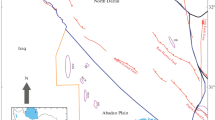Abstract
The distribution of “molecular fossils” (biomarkers) of steroid compounds in extracts from some specific geologic age in the Tarim Basin have been analyzed and are used as the fingerprints for the oil-source rock correlation. Having been affected by maturation, migration, phase fractionation and biodegradation, not any molecular fossils related to source and environment can be used as the fingerprints for oil-source rock correlation. Some special biomarkers widely existed in the extracts from Cambrian and Ordovician rocks in the Tarim Basin and showed obvious difference in each stratum, including dinosteranes (C30), 4-methyl-24-ethyl-cholestanes (C30) and their aromatized steroids, C24-norcholestanes and C28 steranes originated from dinoflagellates and diatom. Few oils such as the heavy oil drilled in the Cambrian reservoir from Tadong 2 well (TD2) correlated well with the extracts from the Cambrian. The amazing similarity of the relative contents of these compounds between the marine oils produced in Tazhong and Tabei uplifts and the extracts from the Upper Ordovician suggests that the Middle-Upper Ordovician is the very likely main source for the marine oils.
Similar content being viewed by others
References
Ourisson, G., Albrecht, P., Rohmer, M., The microbial origin of fossil fuels, Scientific American, 1984, 251: 44.
Petrers, K. E., Moldowan, J. M., The biomarker guide, Interpreting Molecular Fossils in Petroleum and Ancient Sediments (ed. Cliffs, E.), New Jersey: Prentice Hall, 1993, 230–232.
Moldowan, J. M., Trails of life, Chemistry in Britain, 2000, 36: 34.
Zhang, S. C., Moldowan, J. M., Li, M. et al., The abnormal distribution of the molecular fossils in the pre-Cambrian and Cambrian: its biological significance, Science in China, 2002, 45(3): 193.
Zhang, S. C., Hanson, A. D., Moldowan, J. M. et al., Paleozoic oil-source rock correlations in the Tarim Basin, NW China, Organic Geochemistry, 2000, 31: 273.
Moldowan, J. M., Dahl, J., Jacobson, S. R. et al., Chemostratigraphic reconstructuion of biofacies: Molecular evidence linking Cyst-forming dinoflagellates with pre-Triassic ancestors, Geology, 1996, 24(2): 159.
Holba, A. G., Tegelaar, E. W., Huizinga, B. J. et al., 24-norcholestanes as age-sensitive molecular fossils, Geology, 1998a, 26: 783.
Holba, A. G., Dzou, L. I. P., Masterson, W. D. et al., Application of 24-norcholestanes for constraining the age petroleum, Organic Geochemistry, 1998b, 29: 1269.
Grantham, P. J., Wakefield, L. L., Variations in the sterane carbon number distributions of marine source rock derived crude oils through geological time, Organic Geochemistry, 1988, 12: 61.
Volkman, J. K., Barrett, S. M., Dunstan, G. A. et al., A new source of 4-methyl sterols and 5α(H)-stanols in sediments: Prymnesiophyte microalgae of the genus Pavlova, Organic Geochemistry, 1990, 15: 489.
Withers, N., Dinoflagellate sterols, The Biology of Dinoflagelltes (ed. Taylor, F. J. R.), Oxford: Blackwell Scientific, 1987, 316.
Moldowan, J. M., Talyzina, N. M., Biogeochemical evidence for dinoflagellate ancestors in the early Cambrian, Science, 1998, 281: 1168.
Tasch, P., Paleobiology of the Invertebrates: Data Retrieval from the Fossil Record, New York: Wiley & Sons, 1980.
Bian Lizeng, Zhang Shuichang, Zhang Baoming et al., A kind of coccoid dinoflagellates-like fossils gives a new exploration of source of dinosterane in the Early-Middle Cambrian, Chinese Science Bulletin, 2001, 46 (5), 420.
Moldowan, J. M., Lee, C. Y., Watt, D. C. et al., Analysis and occurrence of C26-sterane in petroleum and source rocks, Geochimica et Cosmochimica Acta, 1991, 55: 1065.
Author information
Authors and Affiliations
Corresponding author
About this article
Cite this article
Zhang, S., Liang, D., Li, M. et al. Molecular fossils and oil-source rock correlations in Tarim Basin, NW China. Chin. Sci. Bull. 47 (Suppl 1), 20–27 (2002). https://doi.org/10.1007/BF02902814
Received:
Issue Date:
DOI: https://doi.org/10.1007/BF02902814



